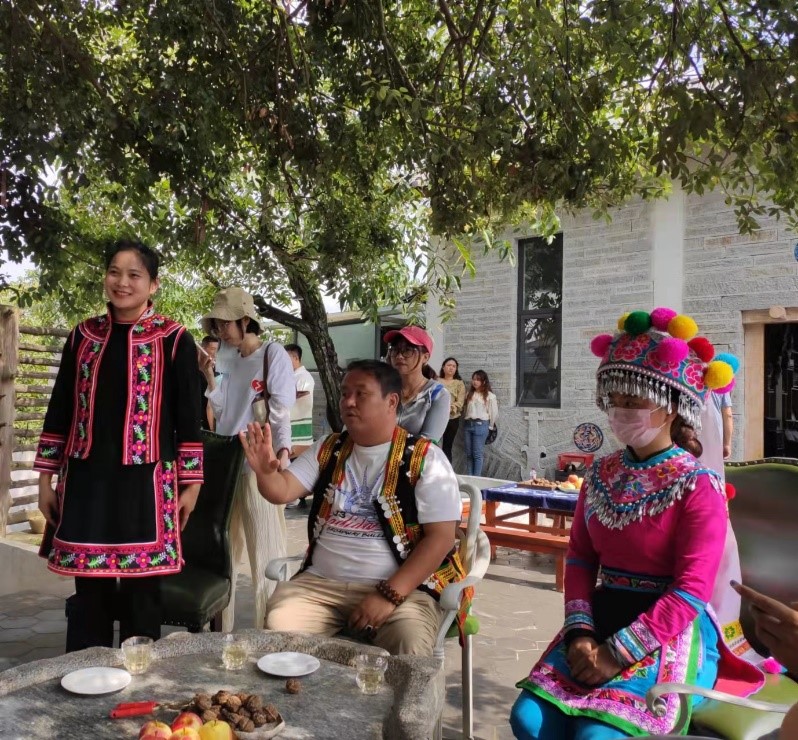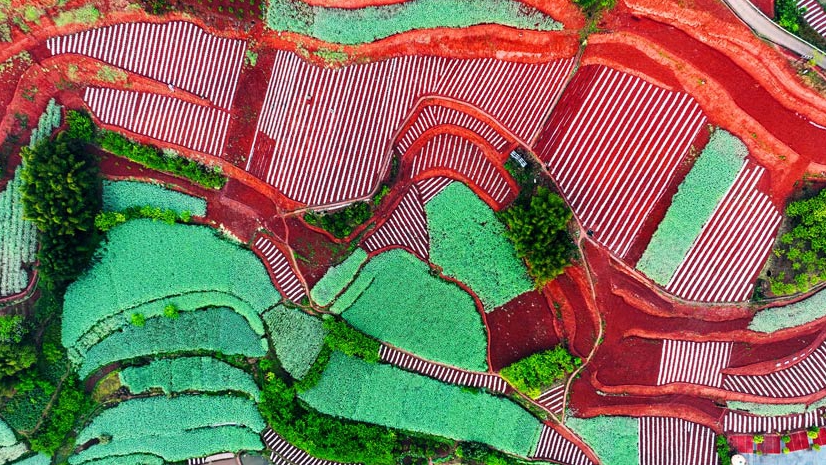A closer look at how Dali of Yunnan Province protects the environment
In an effort to showcase aspects of Dali’s ecological protection and biodiversity conservation efforts, a group of international youths from 18 countries toured the region from August 24 to 28, a trip that was facilitated by the China International Communications Group, China Center for International Communication Development and the Information Office of Yunnan Provincial People’s Government.

Members of the 2022 International Youth Tour to Dali strike a pose on the bank of Erhai Lake. (Photo/ Vicki Cann)
In recent years, Yunnan province has been praised for its biodiversity, environmental protection and ecosystem restoration, with the most noteworthy example being Erhai Lake. Since 2003, the local government has implemented a series of measures to restore the lake and its immediate surroundings. Some of these include: a ban on fishing, the closure of factories emitting pollution, the construction of water treatment plants as well as the mobilization of local garbage collectors who regularly patrol and clean the lake’s shoreline.
Miranda Li, a researcher at the Shan Shui Conservation Center, was among those specially invited young participants, and was impressed by the efforts being made in Erhai.
“I especially enjoyed visiting the Scientific Backyard and learning about how the researchers there were monitoring pollution in Erhai to formulate a scientific decision-making process for pollution management and control. This way, pollution control measures can be targeted towards the activity generating the most pollution in Erhai. The Scientific Backyard also acts as a bridge between local government, residents, corporations, and scientists, involving all stakeholders who would be impacted by pollution control decisions. I was also very inspired to see the Scientific Backyard model being replicated in many places across the country," noted Li.

Participants are treated to Yunnan’s Xiaguan Tuocha during a tour of the company. (Photo/Vicki Cann)
In collaboration with the Dali Bai Autonomous Prefecture People’s Government, a group of researchers and postgraduate students from the China Agricultural University and Yunnan Agricultural University continue to monitor the overall state of the lake’s ecosystem and its water quality.
Participants were treated to a variety of activities, including a tour of the Yunnan Xiaguan Tuocha Company, which has specialized in the production and sale of local tea products that have a long, established history. Having the unique opportunity to hike in Dali’s Cangshan UNESCO Global Geopark, the youngsters got a rare taste of the Cangshan Mountain, hailed as a sacred place by the indigenous Bai ethnic group. From love songs to the celebration of a fictitious marriage ceremony, Bai performers charmed the audience with local music and dancing. Dali is home to 13 local ethnic groups.

Photo shows a picturesque view of Dali’s Cangshan Mountain. (Photo/Vicki Cann)
Li Yongkang, a Yi musician, thrilled participants with his rendition of a Yi love song entitled “Walnut Flower.” The song’s romantic lyrics detail the conundrum of a starstruck lover as he questions, “how will you return my heart, that’s been stolen by you?” The warm hospitality of the Yi people was further felt when members of the community hosted a bonfire party to welcome the international delegation.
Other sites of interest included the Gusheng and Donglianhua Villages, home to the Bai and Hui ethnic groups, respectively. Xizhou Town is revered as a national scenic spot, one that has been praised for its historical and cultural relevance to Dali.

Li Yongkang (center) of the Yi ethnic group shares stories about his community and the charm of Yi music. (Photo/Vicki Cann)
Participants also had the opportunity to tour the Linden Centre, an original Bai style courtyard that has been renovated by Brian and Jeanee Linden to serve as a local boutique hotel and cultural exchange center. It is one of Xizhou’s protected heritage sites and Yang Dong’er, a local cartoonist, was also on hand to interact with the delegation. As an American who was awarded a Chinese scholarship in 1983, Linden remains committed to serving as a bridge of friendship between his country and China.

Members of the Yi ethnic group are seen dancing around a bonfire.
“China gave me opportunities that I would never have in the U.S. and so I wanted to give back to this country by making a social impact in rural areas … When we share more of the positive stories and narratives about China, each of us can make a difference …. To that end, I am working on a book titled, Redefining Diplomacy, One Village at a Time,” said Linden.

Bai performers are seen gearing up for a fictitious marriage ceremony. (Photo/Vicki Cann)
The trip was filled with a number of enriching and meaningful activities, where participants had the opportunity to truly learn more about Dali while also having the ability to interact with locals from different ethnic groups. Cissy Amparo Lavandez Vargas, a Bolivian PhD student, from the University of Science and Technology in Beijing further reiterated this sentiment.
“I think the most inspiring moments for me were when Mr. Li and Brian Linden shared with us their stories. In both cases, they shifted from their lives in the big cities and gave hope and an opportunity to work and develop the small villages. Displaying a considerable amount of passion for what they do and also showing us their accomplishments while giving more to the people around them.”

Brian Linden (3rd right standing) shares the lens with members of the international youth group. (Photo/Vicki Cann)
Photos
Related Stories
- China makes notable achievements in environmental protection: report
- An island's transformation into beauty, prosperity
- Fruit planting helps improve environment and villagers' income in SW China's Chongqing
- China sees rising vegetation coverage from 2000 to 2021: blue paper
- Vice premier stresses improving aquatic environment in north China
- China's environmental inspections pave way for green development
- China achieves win-win situation for economic growth and environmental governance: Cameroonian student in China
- Judicial innovations arouse public environmental awareness
- China is playing a vital role in protecting global environment
- World Oceans Day: Protect our blue planet
Copyright © 2022 People's Daily Online. All Rights Reserved.









